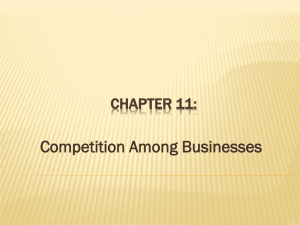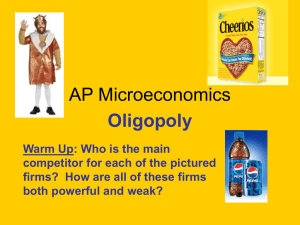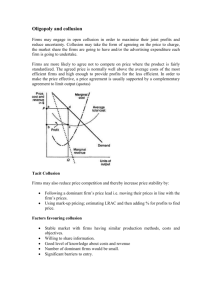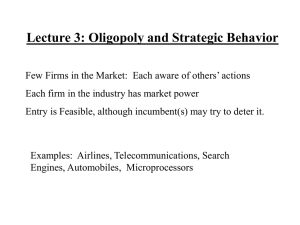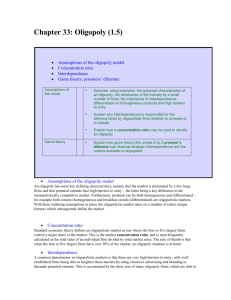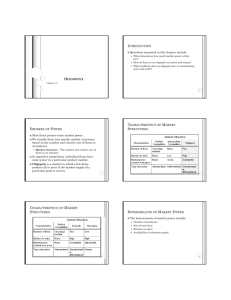SpotNomics Oligopoly
advertisement
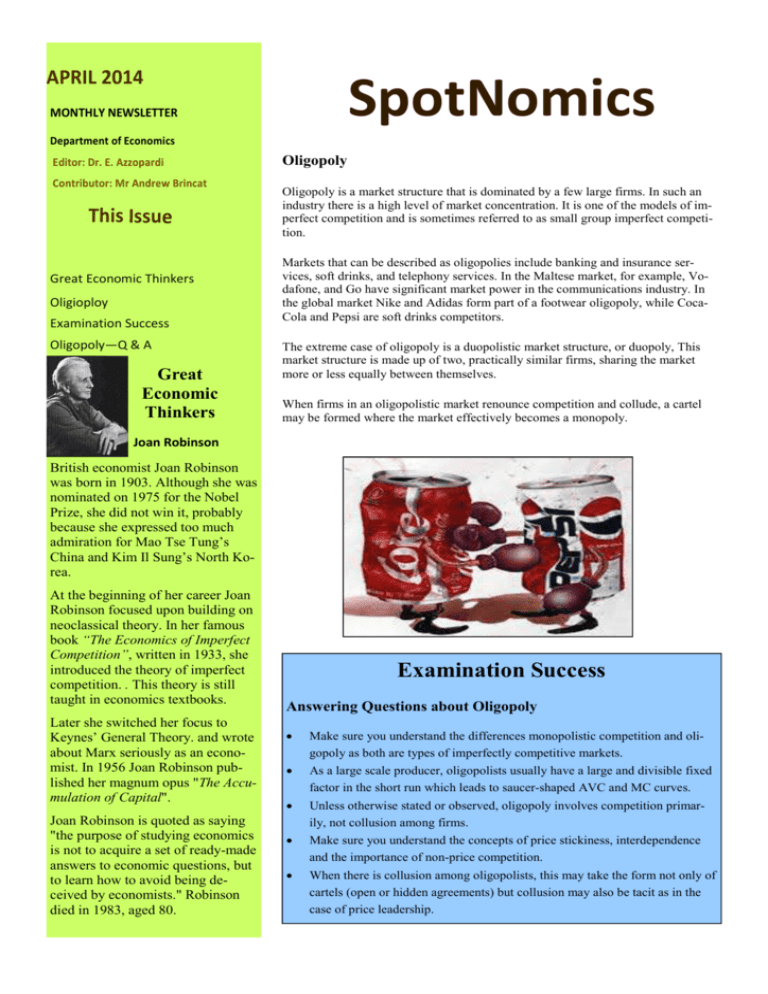
APRIL 2014 SpotNomics MONTHLY NEWSLETTER Department of Economics Editor: Dr. E. Azzopardi Contributor: Mr Andrew Brincat This Issue Great Economic Thinkers Oligioploy Examination Success Oligopoly—Q & A Great Economic Thinkers Oligopoly Oligopoly is a market structure that is dominated by a few large firms. In such an industry there is a high level of market concentration. It is one of the models of imperfect competition and is sometimes referred to as small group imperfect competition. Markets that can be described as oligopolies include banking and insurance services, soft drinks, and telephony services. In the Maltese market, for example, Vodafone, and Go have significant market power in the communications industry. In the global market Nike and Adidas form part of a footwear oligopoly, while CocaCola and Pepsi are soft drinks competitors. The extreme case of oligopoly is a duopolistic market structure, or duopoly, This market structure is made up of two, practically similar firms, sharing the market more or less equally between themselves. When firms in an oligopolistic market renounce competition and collude, a cartel may be formed where the market effectively becomes a monopoly. Joan Robinson British economist Joan Robinson was born in 1903. Although she was nominated on 1975 for the Nobel Prize, she did not win it, probably because she expressed too much admiration for Mao Tse Tung’s China and Kim Il Sung’s North Korea. At the beginning of her career Joan Robinson focused upon building on neoclassical theory. In her famous book “The Economics of Imperfect Competition”, written in 1933, she introduced the theory of imperfect competition. . This theory is still taught in economics textbooks. Later she switched her focus to Keynes’ General Theory. and wrote about Marx seriously as an economist. In 1956 Joan Robinson published her magnum opus "The Accumulation of Capital". Joan Robinson is quoted as saying "the purpose of studying economics is not to acquire a set of ready-made answers to economic questions, but to learn how to avoid being deceived by economists." Robinson died in 1983, aged 80. Examination Success Answering Questions about Oligopoly • Make sure you understand the differences monopolistic competition and oligopoly as both are types of imperfectly competitive markets. • As a large scale producer, oligopolists usually have a large and divisible fixed factor in the short run which leads to saucer-shaped AVC and MC curves. • Unless otherwise stated or observed, oligopoly involves competition primarily, not collusion among firms. • Make sure you understand the concepts of price stickiness, interdependence and the importance of non-price competition. • When there is collusion among oligopolists, this may take the form not only of cartels (open or hidden agreements) but collusion may also be tacit as in the case of price leadership. Oligopoly—Q & A What are the characteristics of oligopoly? There is no single theory of price and output under oligopoly. There are in fact a number of theories that try to explain oligopolistic behaviour. The kinked demand curve, with a number of theoretical reservations, attempts to explain price rigidity or price stickiness as the result of interdependence. The saucer-shaped theory tries to explain price rigidity in view of short term changes in demand. Game theory is also used to analyze strategies to determine the optimal course of action depending on assumptions about rivals’ behaviour. Some of the main features exhibited by oligopolistic market structures include: Price stickiness— the reluctance of firms to raise or lower price in the face of changing circumstances. Interdependence— this means that the decisions of one firm are dependent on the perceived reactions of the other firm or firms. Non-price competition— the use of factors other than price to compete with rivals in the industry. This may take the form of heavy advertising, sponsorships, use of location, product branding, product proliferation. Many oligopolists fight for market share in order to fulfill their profit motives. Product proliferation—the introduction of different varieties and brands of the same type of product or related product to appeal to different and changing buyer preferences with the intention of retaining custom and not lose it to competing firms. Barriers to entry: entry barriers maintain supernormal profits for the dominant firms. It is possible for many smaller firms to operate on the periphery of an oligopolistic market, but none of them is large enough to have any significant effect on prices and output What is collusive oligopoly? Does oligopoly serve the public interest? Collusion in a market or industry may occur of the following features are present: • There are only a small number of firms in the industry and there are significant barriers to prevent new firms entering the industry • Market demand is not too variable (or cyclical) i.e. it is reasonably predictable and not subject to violent fluctuations which may lead to excess demand or excess supply. • Demand is fairly inelastic with respect to price so that a higher cartel price increases the total revenue to suppliers – this is easier when the product is viewed as a necessity. • Each firm’s output can be easily monitored. This enables the cartel more easily to control total supply and identify firms who are cheating on output quotas. • Incomplete information about motivation of other firms may induce tacit collusion. It is very difficult to draw any general conclusions about oligopolistic behaviour since oligopolists differ so much in their performance. Collusion may take the form of a cartel, a group of firms acting as one. Usually this may take the form of overt (open) collusion or covert (hidden) collusion and usually involves price fixing. Tacit collusion occurs where firms undertake actions that are likely to minimise a competitive response, for example, avoiding price cutting or not attacking each other’s market . Tacit collusion may take to form of: If oligopolists act collusively, they bring the same disadvantages to the market as in monopoly. Moreover, there may be less scope for economies of scale and may be likely to engage in more extensive advertising. However, these disadvantages may be mitigated (lessened) if oligopolists do not collude, if there is some price competition and if barriers to entry are weak, making the market more contestable. The power of oligopolists may also be weakened if buyers have some degree of market power. This is known as countervailing power, and may be present in intermediate markets but very difficult to find in consumer markets. On the other hand, oligopolists may use part of their supernormal profits for research and development, especially if they compete on innovative, differentiated and quality products. Consumers may benefit also from the firms’ motive to defend or grow market share, and from increased choice from product proliferation. Dominant price leadership— firms follow the example set by the dominant firm and choose to set the same price set by the leaser. Barometric firm price leadership— the price leaser is that firm whose prices are believed to reflect the prevailing market conditions in the most satisfactory way. Rules of thumb—certain pricing standards may be adopted which may not necessarily result in immediate profits, but serve to curb competition leading to future profits. Sources for this newsletter: www.tutor2u.com www.econlib.org www.britannica.com Sloman, J. Economics 7th Edition, Prentice Hall, 2009 taramillermicroeconomics.wordpress.com


